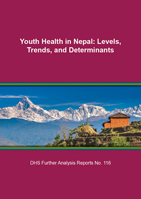- PUBLICATIONS
- JOURNAL ARTICLES
- ACCESS PUBLICATIONS
Publications Summary
- Document Type
- Further Analysis
- Publication Topic(s)
- Domestic Violence, Family Planning, Gender, Youth
- Country(s)
- Nepal
- Survey
- Nepal DHS, 2016
- Language
- English
- Recommended Citation
- Kafle, Ramesh Babu, Rasmita Paudel, Pragya Gartoulla, and Kerry L. D. MacQuarrie. 2019. Youth Health in Nepal: Levels, Trends, and Determinants. DHS Further Analysis Reports No. 116. Rockville, Maryland, USA: ICF.
- Download Citation
- RIS format / Text format / Endnote format
- Publication Date
- January 2019
- Publication ID
- FA116
Download
 Youth Health in Nepal: Levels, Trends, and Determinants (PDF, 5013K)
Youth Health in Nepal: Levels, Trends, and Determinants (PDF, 5013K)
Download this publication
There is no printed copy available to order.
